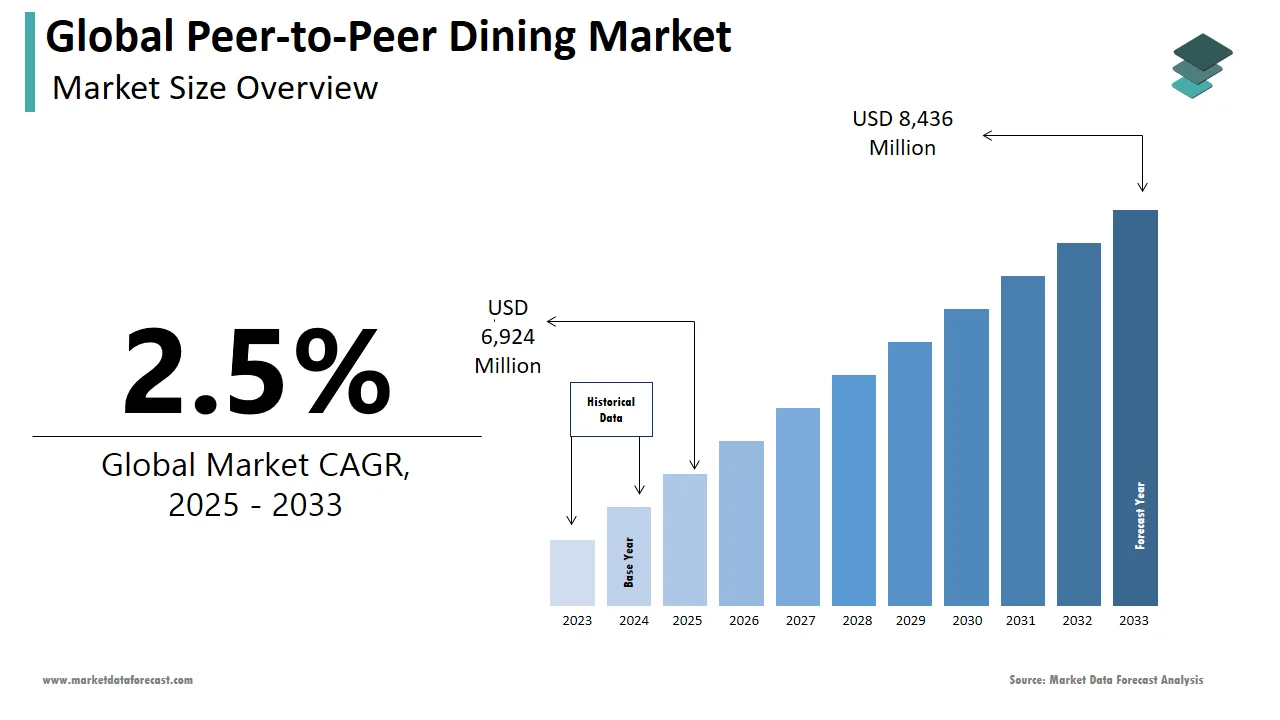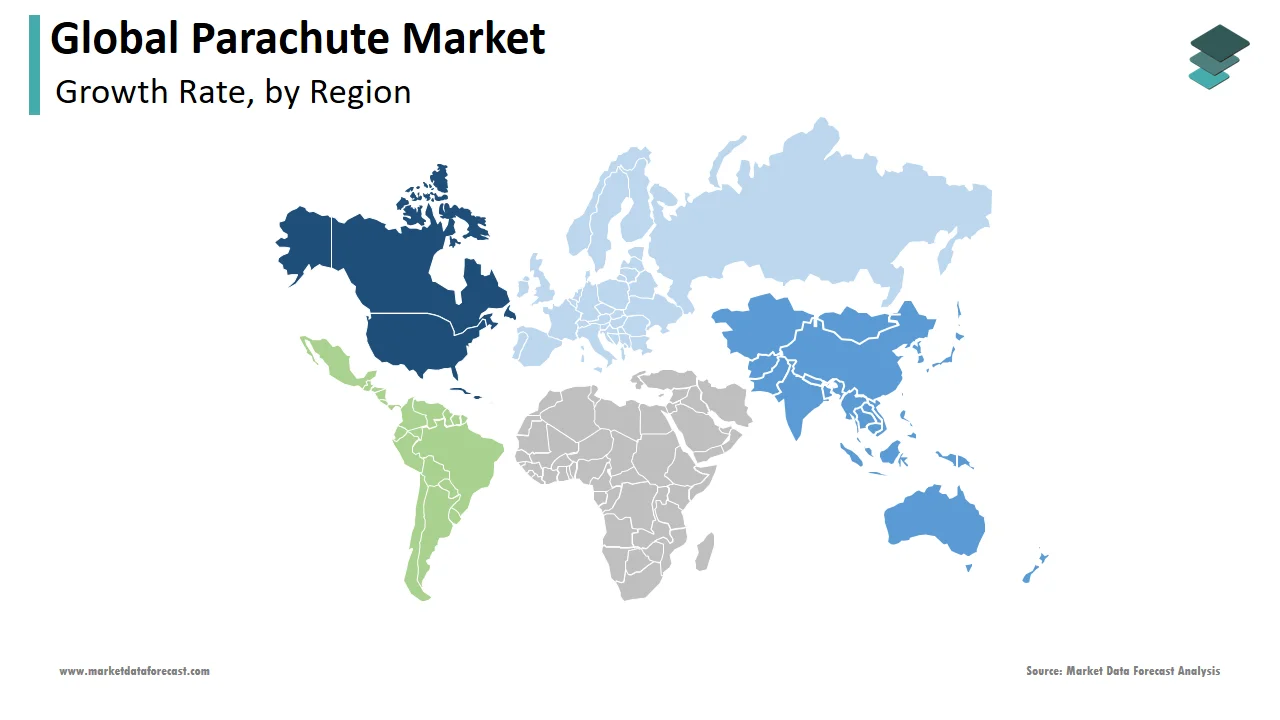Global Peer-to-Peer Dining Market Size, Share, Trends & Growth Forecast Report By Dining (Casual Home Dining, Fine Dining, Themed Dinners, Food Tours) By Booking Channel (Direct Bookings, Online Travel Agencies (OTAs), Other Booking Platforms), By Age Group (Below 15 years, 16 to 25, 26 to 35, 36 to 45, 46 to 55, above 55 ), and Region (North America, Europe, Asia-Pacific, Latin America, Middle East and Africa), Industry Analysis From 2025 To 2033.
Global Peer-to-Peer Dining Market Size
The size of the global peer-to-peer dining market was worth USD 6,755 million in 2024. The global market is anticipated to grow at a CAGR of 2.5% from 2025 to 2033 and be worth USD 8,436 million by 2033 from USD 6,924 million in 2025.

Peer-to-peer dining, often called social dining or supper clubs, is a friendly and informal way of sharing meals. In this unique dining experience, regular people become hosts, opening their homes to strangers or friends for a special meal. These hosts usually prepare and serve the food themselves, showcasing their cooking skills and culture. Guests can join these meals by booking a seat, and they get to enjoy not only delicious homemade dishes but also the company of new people. Peer-to-peer dining is all about connecting over food, making new friends, and experiencing diverse cuisines in a cosy, homey atmosphere. It's like having a restaurant experience right in someone's home.
MARKET DRIVERS
The peer-to-peer dining market is gaining popularity because it satisfies the craving for genuine and one-of-a-kind food adventures. Travelers and food enthusiasts seek authentic and unique culinary experiences.
Peer-to-peer dining allows them to savor homemade dishes and traditional recipes from local hosts, providing a taste of the region's culture. As a result, this culinary exploration is driving the Peer-to-Peer Dining market growth and attracting those who hunger for authentic and unique dining experiences.
Peer-to-peer dining is growing due to its affordability. These dining experiences typically cost less than dining at restaurants, which is a big draw for both travelers and locals seeking budget-friendly dining options. Whether you're a traveller seeking economical yet delightful meals or a local looking for cost-effective dining choices, peer-to-peer dining offers a wallet-friendly option without compromising on taste or quality. Therefore, this affordability factor contributes to the growing popularity of peer-to-peer dining in the market.
MARKET RESTRAINTS
The peer-to-peer dining market faces significant restraints due to its limited availability, especially in less populated or remote areas.
While these dining experiences can be popular in cities and tourist hubs, travelers venturing into more remote regions might struggle to find such unique dining opportunities. This limitation could hinder their ability to explore local cuisine through peer-to-peer dining, and hosts may be scarce in these less-traveled areas. As a result, it impacts the market's accessibility for a broader range of travelers and impedes the peer-to-peer dining market growth.
MARKET OPPORTUNITIES
The peer-to-peer dining market creates significant opportunities due to the Incorporation of mobile apps and advanced technology. User-friendly apps for booking reservations, browsing menus, and leaving reviews can make the process smoother and more accessible. This tech-savvy approach aligns with the preferences of modern consumers and can attract a broader audience of diners, boosting the peer-to-peer dining market demand. This kind of dining not only enhances convenience but also improves transparency and trust, which contributes to the success of these unique culinary adventures.
IMPACT OF COVID-19 ON THE GLOBAL PEER-TO-PEER DINING MARKET
The COVID-19 pandemic had a significant impact on the peer-to-peer dining market. Initially, Social distancing measures and safety concerns led to a decline in bookings and dining experiences. Many hosts had to suspend their offerings due to health restrictions temporarily. However, the market also adapted to the new normal. Some hosts shifted to offering takeout and delivery services to accommodate changing consumer preferences. Enhanced hygiene protocols and safety measures were implemented to reassure diners. As restrictions eased, there was a resurgence in interest in peer-to-peer dining experiences, with people craving unique culinary adventures. The pandemic emphasized the importance of supporting local hosts and enjoying homemade meals in a safe environment. This shift in consumer behaviour may continue to shape the future of the peer-to-peer dining market.
REPORT COVERAGE
|
REPORT METRIC |
DETAILS |
|
Market Size Available |
2024 to 2033 |
|
Base Year |
2024 |
|
Forecast Period |
2025 to 2033 |
|
CAGR |
2.5% |
|
Segments Covered |
By Dining, Booking Channel, Age Group, and Region. |
|
Various Analyses Covered |
Global, Regional & Country Level Analysis, Segment-Level Analysis, DROC, PESTLE Analysis, Porter’s Five Forces Analysis, Competitive Landscape, Analyst Overview of Investment Opportunities |
|
Regions Covered |
China, India, Japan, South Korea, Australia, New Zealand, Thailand, Indonesia, Philippines, Vietnam, Singapore, Rest of APAC. |
|
Market Leaders Profiled |
EatWith, VizEat (now called EatWith), Feastly, Withlocals, BonAppetour, TravelingSpoon, CozyMeal, HomeDine, SupperShare, Bookalokal, and Others. |
SEGMENT ANALYSIS
By Dining Insights

The casual home dining segment is leading with the dominant Peer-to-Peer Dining Market shares due to its appeal to travellers and diners seeking authentic, budget-friendly, and socially interactive dining experiences. This dining type offers diverse options, making it the top choice for those looking to savour local culture and cuisine in a welcoming and relaxed atmosphere.
By Booking Channel Insights
Direct bookings dominate the Peer-to-Peer Dining Market value due to cost efficiency, personalized communication, and transparency. Booking directly with hosts or platforms eliminates extra fees, encourages direct communication for preferences, and offers clarity, boosting diners' confidence and overall experience.
By Age Group Insights
The age group 26-35 segment is leading with the largest shares of the peer-to-peer dining market whereas the 36-35 age group segment has been growing at a higher rate for past few years. Increasing the priority to experience unique dining among these age groups is enhancing the market growth rate.
REGIONAL ANALYSIS

North America is dominating the Peer-to-Peer Dining Market share due to its diverse dining culture, tech-savvy population, and high tourist footfall. This region's well-established tourism industry, coupled with a propensity for digital adoption, positions it as a thriving hub for peer-to-peer dining experiences. North America leads the way in shaping the future of this culinary trend. Europe also holds a significant share of the peer-to-peer dining market following North America. With a rich culinary heritage and a focus on local, authentic flavors, Europe attracts both hosts and diners. The Asia-Pacific region, including countries like Thailand, Japan, and India, is experiencing a growing trend in peer-to-peer dining that is likely to propel the growth rate of the market. The popularity of street food and the desire to explore traditional dishes have contributed to its dominance. The Middle East and Africa peer-to-peer dining market is deemed to gain traction over the growth rate at a steady pace in the coming years. Urban hubs like Dubai and Cape Town are witnessing a rise in hosted dining experiences, attracting tourists seeking local flavours and unique encounters. Latin America has a budding peer-to-peer dining scene, particularly in countries like Mexico and Brazil.
KEY MARKET PLAYERS
Companies playing a prominent role in the global peer-to-peer dining market include EatWith, VizEat (now called EatWith), Feastly, Withlocals, BonAppetour, TravelingSpoon, CozyMeal, HomeDine, SupperShare, Bookalokal, and Others.
RECENT MARKET HAPPENINGS
- In 2021, Eatwith expanded its services to various countries, including the United States, Spain, France, Italy, and many more. They offer a wide range of culinary experiences hosted by locals, providing guests with the opportunity to explore diverse cuisines and cultures.
- In 2022, Traveling Spoon hosts offer dining experiences in various settings, including traditional outdoor kitchens, lush gardens, and countryside farmhouses. These settings provide an authentic and unique experience.
MARKET SEGMENTATION
This global peer-to-peer dining market research report has been segmented and sub-segmented based on dining, booking channel, age group and region.
By Dining
- Casual Home Dining
- Fine Dining
- Themed Dinners
- Food Tours
By Booking Channel
- Direct Bookings
- Online Travel Agencies (OTAs)
- Other Booking Platforms
By Age Group
- Below 15 years
- 16 to 25
- 26 to 35
- 36 to 45
- 46 to 55
- above 55
By Region
- North America
- Europe
- Asia Pacific
- Latin America
- Middle East & Africa
Frequently Asked Questions
1. What is the CAGR of the Peer-to-Peer Dining Market from 2025-2033?
The Peer-to-Peer Dining Market is expected to grow with a CAGR of 2.5% during the forecast period.
2. Which is the dominating region for the Peer-to-Peer Dining Market share?
North America region is currently dominating the Peer-to-Peer Dining Market share by region.
3. Which age group type is dominating the market for Peer-to-Peer Dining Market?
The "26 to 35" age group dominates the Peer-to-Peer Dining Market by age group type.
Related Reports
Access the study in MULTIPLE FORMATS
Purchase options starting from
$ 2500
Didn’t find what you’re looking for?
TALK TO OUR ANALYST TEAM
Need something within your budget?
NO WORRIES! WE GOT YOU COVERED!
Call us on: +1 888 702 9696 (U.S Toll Free)
Write to us: sales@marketdataforecast.com